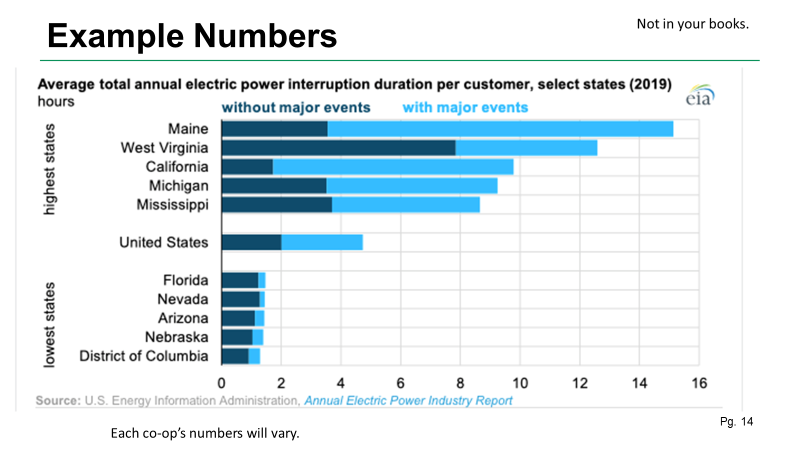Joe Slater’s presentation and video on Co-operative Utility Ownership and lessons for Maine
Joe Slater
Joe joined the group to discuss the cooperative model of public power ownership. Included below are some graphics about Maine’s utility performance, a downloadable copy of Joe’s presentation, a link to the video recording of the Zoom meeting we held with Joe, and an explanation of the different types of utility ownership.
First, a bit about Joe:
Austin J. Slater, Jr. has 40-years’ experience as an executive in the energy industry, retiring March 2020 following 18-years as President and CEO of the Southern Maryland Electric Cooperative. He formerly served as VP for Education and Training at National Rural Electric Cooperative Association (NRECA) in Arlington, Virginia, and as General Manager of Tideland EMC in eastern North Carolina. Slater has served as a Board Member and Chairman of the Board of ACES Power Marketing and was a founding Member and Secretary of the National Renewables Cooperative Organization.
Slater is presently Board Vice Chairman of a publicly traded $6-billion community bank that operates in Delaware, Maryland, and Virginia. In 2021 Slater was appointed to the Board of Governors of Shepherd University by West Virginia Governor Jim Justice. He also serves as Board Member and Treasurer for the Shepherd University Foundation; an instructor in NRECA’s Director Education curriculum; and an active member of the Shepherdstown Rotary Club.
Some Revealing Graphics about Maine’s Performance



Presentation Slides
Electric Cooperatives 101 for Maine (ppt, download)
Presentation Video
Zoom recording of Joe Slater’s presentation and discussion
The Three Types Of U.S. Electric Utilities
During the discussion with Joe he explained the three types of utility ownership, co-op, investor-owned, and municipal. Joe puts PTP in the municipal category.

Cooperatives, or co-ops, are not-for-profit member-owned utilities. There are 832 distribution and 65 generation/transmission Co-ops in 48 states. The largest co-op is Pedernales Electric Co-op, in Johnson City, Texas, with 357,785 customers. Co-ops serve 60% of the US land mass and own/operate 42% of the nation’s power lines. Co-ops are exempt from income tax but do pay property taxes. They qualify for disaster-related FEMA reimbursement. Maine has three electric co-ops: Eastern Maine EC, Fox Island EC, and Isle De Haute EC.
Investor-owned utilities, or IOUs, are large electric distributors that issue stock owned by shareholders. Almost three-quarters of utility customers get their electricity from these companies. IOUs are most prevalent in heavily populated areas on the East and West coasts. In 2017, 168 IOUs served an average of 654,600 electric customers. The two largest IOUs are in California: Pacific Gas and Electric, with 5.48 million customers, and Southern California Edison Company, with 5.07 million customers. Maine has two IOUs: Central Maine Power and Versant Power.
Municipal, publicly owned utilities, or POUs, include federal-, state-, and municipal-run utilities. In addition to government entities, political subdivisions may run POUs, also called public utility districts—utilities that residents vote into existence that operate independently of city or country government. The United States has 1,958 POUs with an average of 12,100 electricity customers each. The largest POUs are the state-run Puerto Rico Electric Power Authority (PREPA), with 1.47 million customers, and the Los Angeles Department of Water and Power, a municipal utility with 1.43 million customers. Maine Munis include Kennebunk P&L District, Madison Electric Works, Matinicus Plantation Electric, Monhegan Plantation Power Dist. and Van Buren Light & Power.